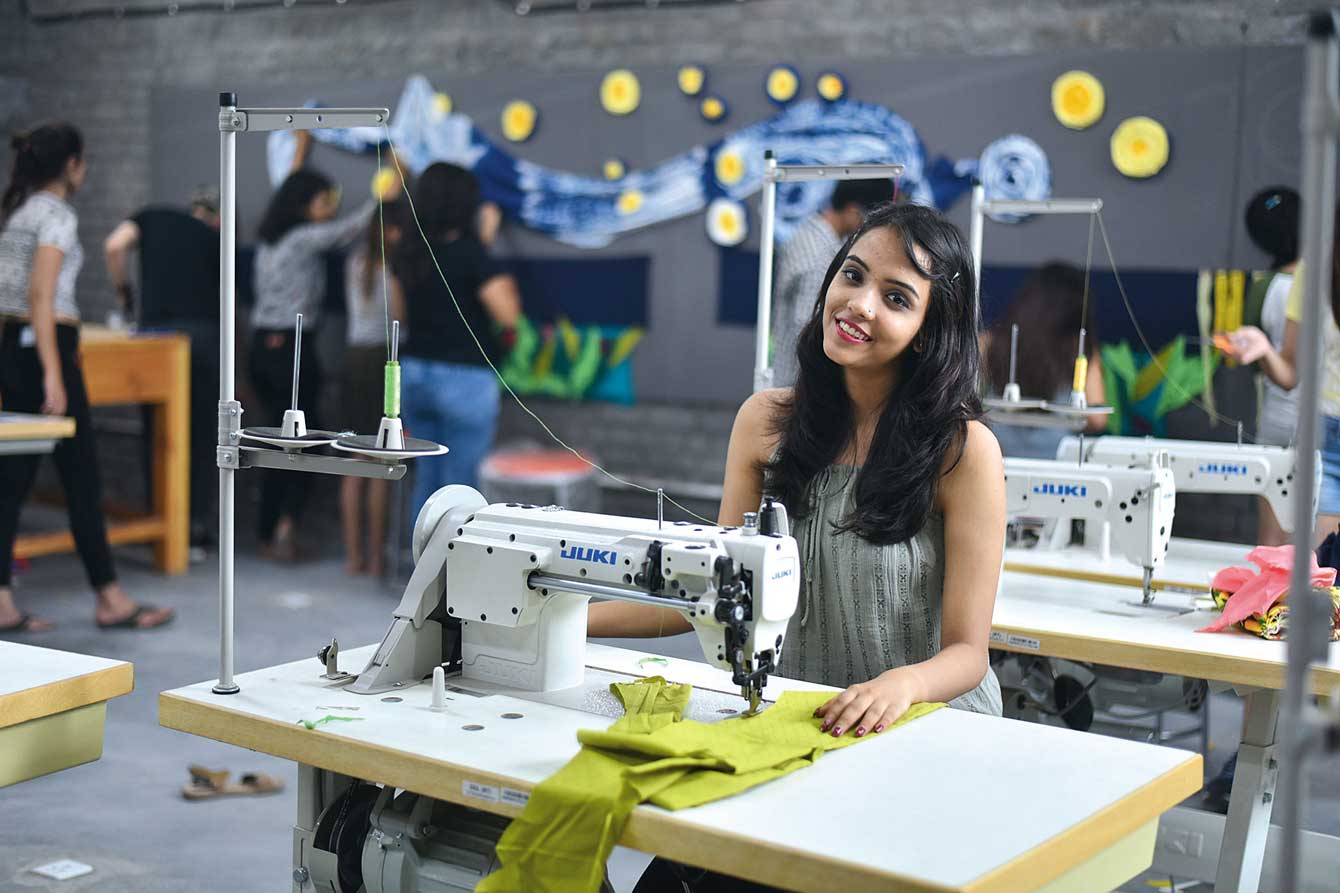Fashion design as a profession tends to attract many people at an early age, but people often tend to focus only on the glamorous side of it and overlook all the work that goes behind becoming a successful fashion designer. Fashion is propagated as a…
How To Become a Fashion Designer?
Fashion design as a profession tends to attract many people at an early age, but people often tend to focus only on the glamorous side of it and overlook all the work that goes behind becoming a successful fashion designer.
Fashion is propagated as a mere expression of logos, seasonal wear and colors, limited to screens and reels. This notion is not only limiting but also misleading.
We are at a point of transition in terms of time where what is relevant today may not remain so in the future. That being said, there are various points one needs to keep in mind when starting out as a fashion designer.
How to get into the fashion design career?
Becoming a designer does not always necessitate getting a degree, however one cannot overlook the exposure and training a fashion designing course brings in.
No matter how talented one may be, guidance from industry leaders helps a student maximise their potential. Many fashion designers often combine their degree in fashion with marketing and business, setting them up for building their own label in the future, where they not only design but also run their business.
Education is important and a degree from a prestigious design institute is an important addition to one’s resume, however no fashion designing degree can teach one to be creative but only push you in the right direction.
The basic qualification for pursuing an undergraduate course or Bachelor’s in Design (B.Des.) in fashion and textile design is 10+2 in any stream from a recognized board(CBSE, I.B or any state board).
To get an admission at The Design Village(TDV), a student must go through the TDV admission procedure, it is a 3 tier procedure which includes a submission of a statement of purpose (S.O.P), entrance exam with a situation test and a round of personal interview.
To enrol in the post graduate program or Master’s in Design (M.Des) in fashion and textile design, the basic qualification required is a UGC recognised undergrad degree in any field.
The aim of the test is to evaluate and know more about a students creative flair and to see their natural inclination to any particular field or silo, it also assesses the creative thinking and logical reasoning skills of a student.
What Does Fashion Designing Course Teach You?
The focus of the programme is to equip the students with tools and techniques which can help them to become a fashion and textile designer who doesn’t only solve problems of today but also proposes new ways for the future. Areas of focus include :
- Making – It includes a history of yarn and science of yarn, weaving and knitting, Industrial manufacturing production and processes.
- Surface – It includes learning techniques of dyeing, printing and surface appliqués.
- Manifestation – This includes illustration, Pattern making, Draping and Construction of Garments and Lifestyle products.
In addition courses like Implications of Design, Visual Aesthetics, Conflicting concerns, Context Mapping, Design for values, and many more are offered as electives alongside.
What to do before joining the fashion industry
Design cannot happen in isolation, although a design institute plays a major role in the development of a designer, one still remains in a bubble surrounded by like minded people.
For a growth as a complete designer, one needs to step out of that comfort zone and experience the real world. This experience comes in the form of internships.
Through internships, one not only learns about styles and fabrics but also develop their marketing and sales skills. Doing multiple internships during the course one’s education is of utmost importance.
Gain Knowledge About the Past, Present & Future of Fashion
Fashion design has been a sector which has been vastly explored yet remains to be one of fields with unfathomable depth. This being said, learning about the past, present and future of the field becomes of utmost importance. Doing so not only increases a students knowledge, but also makes them more aware of the field allowing them to design something which not only is relevant for today but is timeless in nature.
Area of Expertise
After completing the foundation year, a student usually is able to determine their field of interest. That doesn’t not mean they find their style/ area of expertise. That only comes with a lot of work and experience.
While jack of all trades and master of none does not sound like an optimal approach, starting out, students/ budding designers should take on a wide range of projects.
This not only helps in eliminating the fields they do not like but also bring out their area of expertise.
Portfolio
A portfolio is a representation of oneself. It is the first thing anyone would see even before they meet a person and thus it is extremely important to invest one’s time in developing a portfolio which speaks about you.
The time spent at a design institute is the optimal time to build a strong portfolio, by working on each project with the same rigour and zeal as that of a professional project, one can develop an impressive portfolio by the time they finish their course. That being said, the work done during internships is also an important addition to the portfolio.
Expanding your network
During the course of one’s program, a student comes in contact with many people from the industry- designers and more. It becomes imperative that they keep in touch with them, this not only keeps them connected to the industry but also opens new avenues for them while looking for jobs, internships and other opportunities. A letter of recommendation from stalwarts in the field goes a long way.
Attention to details
Ludwig Mies van der Rohe had said “God is in the details”. The difference between a good design and a great design is the attention paid to the details.
They are not always the obvious things like colour, placement etc, but more in terms of the nuanced things which are harder to define like a user’s experience with a design.
Becoming a fashion designer is not easy, it is a competitive world; nevertheless, with dedication and commitment one can make big in the field.
With time the lens of fashion mandates a shift into a compassionate parallax of belonging and being belonged. A social construct of a circular economy, encouraging sustainable and long lasting ideologies that promote home grown and value what is hand- crafted.
With time the lens of fashion mandates a shift into a compassionate parallax of belonging and being belonged. A social construct of a circular economy, encouraging sustainable and long lasting ideologies that promote home grown and value what is hand- crafted.
Fashion Design has become famous among many creative minds but to say that the fashion industry has peaked would be an inaccurate statement.
Yes, there are numeros mainstream fashion designers but it is not just an expression of logos, seasonal wear and colors, limited to screens and reels.
Before stepping into the field of design, one must define ‘why’ they want to do so, following that comes ‘what they want to do in fashion, fashion is not just about creating a piece of clothing.
It is purposed to be an inadvertent essence of self, a collective, a community at large – the world we inhabit, our habits, our motion and function. We stand at the cusp of transitioning into an unprecedented future where what is relevant today might lose its existence tomorrow or cease to be instrumental anymore.
This thus, recalls a glance into the pensive. The lens of fashion mandates a shift into a compassionate parallax of belonging and being belonged.
A social construct of a circular economy, encouraging sustainable and long lasting ideologies that promote home grown and value what is hand- crafted. This opens up countless new avenues to be explored in fashion.
Perks of working as Fashion Designer
- Creating one’s own brand and identity
- Working towards one’s passion
- One’s work becomes a form of expression
Career Options and Opportunities in Fashion Designing
India holds around 14 percent share in the production of textile fibres and yarn, and around 63 percent share in loom production in the global market. These figures indicate the scope in Indian market. After graduating as Bachelor of Fashion Design, a student can choose to engage in their career as:
- Fashion Designer
- Textile Designer
- Lifestyle Designer
- Fashion Blogger
- Brand Manager
- Fashion Merchandiser
- Fashion Illustrator
- Fashion Stylist
- Fashion Journalist
- Fashion Photographer
- Fashion Publicist
- Costume Designer
- Fashion Consultant
- Fashion Curator
- Visual Merchandiser
- Design Entrepreneur
- Strategy Designer
- Design Researcher
- Systems Designer
- Social Designer
- Chief Design Officer
- Chief Creative Officer
- Design Thinker
- Design Manager






